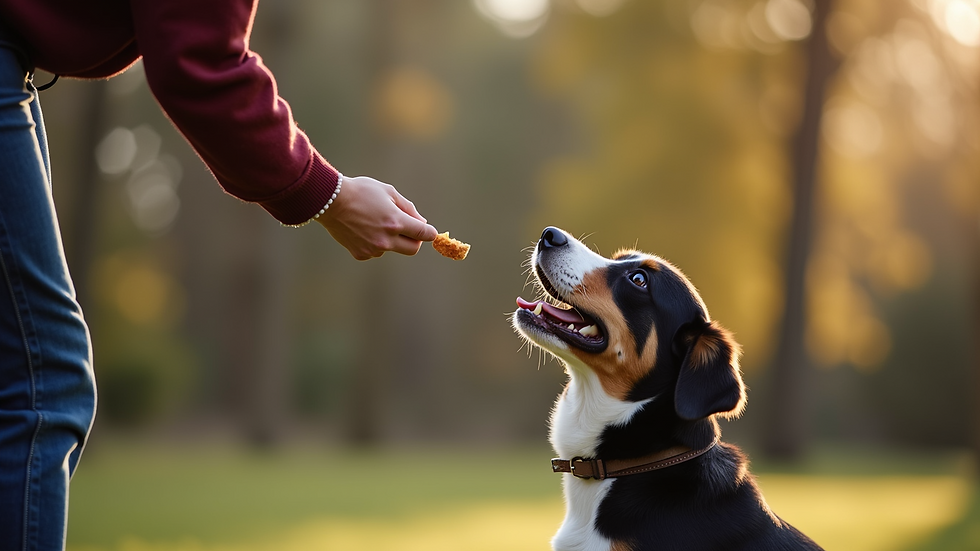Healthy Snacking Tips for Your Beloved Pet
- hmroberts1216
- Aug 6
- 3 min read
Treats are a fun and rewarding way to bond with your pet. However, not all treats are created equal. Choosing the right treats can support your pet’s health, energy, and happiness. This guide will help you understand how to pick and offer snacks that are both delicious and nutritious for your furry friend.
Understanding the Importance of Healthy Pet Snacks
Pets, like humans, benefit from a balanced diet that includes occasional treats. Treat snacks can be used for training, rewarding good behavior, or simply showing love. But unhealthy snacks can lead to weight gain, digestive issues, allergies and worse problems.
When selecting snacks, look for options that are low in calories, free from artificial additives, and rich in natural ingredients. For example, snacks made from real meat, vegetables, or fruits can provide essential vitamins and minerals.
Tips for choosing healthy snacks:
Check ingredient lists for natural components.
Avoid snacks with excessive salt, sugar, or fillers.
Consider your pet’s specific dietary needs or restrictions.
Use snacks in moderation to prevent overfeeding.
Offering your pet healthy pet snacks like those sold by Stedman's Snack Emporium can improve their overall well-being and keep them active and happy.

How to Incorporate Healthy Pet Snacks into Your Pet’s Diet
Introducing snacks into your pet’s routine should be done thoughtfully. Here are some practical ways to include treats without disrupting their main meals:
Use snacks as training rewards: Positive reinforcement helps pets learn commands and good behavior.
Replace table scraps with healthy snacks: Avoid giving pets human food that may be harmful to their health or create bad habits.
Schedule snack times: Consistency helps regulate your pet’s appetite.
Monitor portion sizes: Treats should not exceed 10% of your pet’s daily calorie intake.
You can also try homemade snacks using simple ingredients like pumpkin, sweet potatoes, or lean meats. These options are often fresher and free from preservatives.

What is the Healthiest Snack You Can Give a Dog?
Choosing the healthiest snack for your dog depends on their size, age, and health condition. Generally, snacks that are low in fat and high in protein are excellent choices. Some of the best options include:
Carrot sticks: Low in calories and high in fiber and vitamins.
Apple slices: Provide antioxidants and vitamins but remove seeds before offering.
Plain cooked chicken: A lean protein source without seasoning.
Green beans: Low-calorie and rich in vitamins.
Commercial treats made with natural ingredients: Look for products with minimal additives.
Avoid snacks that contain chocolate, grapes, onions, or artificial sweeteners, as these can be toxic to dogs.
Always introduce new snacks gradually and observe your dog for any adverse reactions.

Homemade vs. Store-Bought Healthy Pet Snacks
Both homemade and store-bought snacks have their advantages. Homemade treats allow you to control ingredients and avoid preservatives. They can be customized to your pet’s preferences and dietary needs.
However, store-bought snacks offer convenience and often come with nutritional information and quality assurance. When choosing commercial snacks, opt for reputable brands that prioritize natural ingredients and transparency.
Pros of homemade snacks:
Control over ingredients and portion size.
Ability to cater to allergies or sensitivities.
Freshness and absence of artificial additives.
Pros of store-bought snacks:
Convenience and longer shelf life.
Variety of flavors and textures.
Often fortified with vitamins and minerals.
Whichever option you choose, always prioritize your pet’s health and consult your veterinarian if you have concerns.
Tips for Safe and Enjoyable Snacking
To make snacking a positive experience for your pet, keep these safety tips in mind:
Avoid choking hazards: Cut snacks into appropriate sizes.
Store snacks properly: Keep them fresh and free from contamination.
Watch for allergies: Introduce new snacks slowly and monitor reactions.
Balance treats with exercise: Prevent weight gain by maintaining activity levels.
Use snacks as part of training: Reinforce good behavior and mental stimulation.
By following these guidelines, you can ensure that snacking remains a healthy and enjoyable part of your pet’s life.
Snacking is more than just a treat - it’s a way to show your pet love and care. By choosing the right snacks and offering them responsibly, you contribute to your pet’s health and happiness. Explore options, try new recipes, and always keep your pet’s well-being at the forefront. Your furry friend will thank you with wagging tails and joyful purrs!



Comments